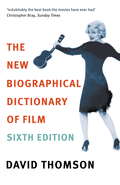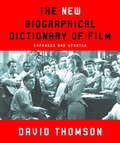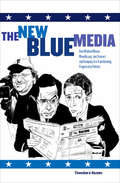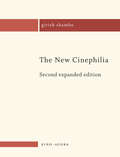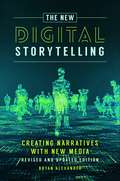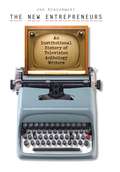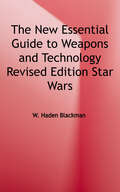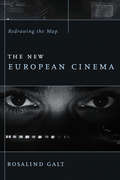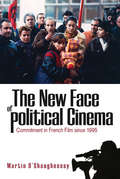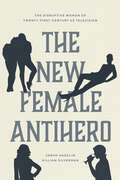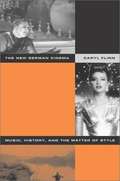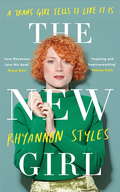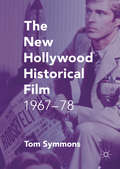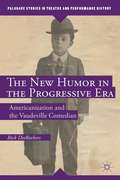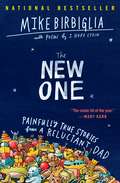- Table View
- List View
The New Biographical Dictionary Of Film 5Th Ed
by David ThomsonThis book is both more and less than history, a work of imagination in its own right, a piece of movie literature that turns fact into romance.' Gavin Lambert was reviewing the first edition of David Thomson's monumental work in 1975. In the eight years since the third edition was published, careers have waxed and waned, reputations been made and lost, great movies produced, trends set and scorned.This fourth edition has 200 entirely new entries and every original entry has been re-examined. Thus the roster of directors, actors, producers, screenwriters and cameramen is both historical and contemporary, with old masters reappraised in terms of how their work has lasted.Each of the 1,000 profiles is a keenly perceptive, provocative critical essay. Striking the perfect balance between personal bias and factual reliability, David Thomson - novelist, critic, biographer and unabashed film addict - has given us an enormously rich reference book, a brilliant reflection on the art and artists of the cinema.
The New Biographical Dictionary Of Film 6th Edition
by David ThomsonWith more than one hundred new entries, from Amy Adams, Benedict Cumberbatch and Cary Joji Fukunaga to Joaquin Phoenix, Mia Wasikowska and Robin Wright, and completely updated, here from David Thomson - 'The greatest living writer on the movies' (John Banville, New Statesman); 'Our most argumentative and trustworthy historian of the screen' (Michael Ondaatje) - is the latest edition of The New Biographical Dictionary of Film, which topped Sight & Sound's poll of international critics and writers as THE BEST FILM BOOK EVER WRITTEN.
The New Biographical Dictionary of Film
by David Thomson'This book is both more and less than history, a work of imagination in its own right, a piece of movie literature that turns fact into romance. ' Gavin Lambert was reviewing the first edition of David Thomson's monumental work in 1975. In the eight years since the third edition was published, careers have waxed and waned, reputations been made and lost, great movies produced, trends set and scorned. This fourth edition has 200 entirely new entries and every original entry has been re-examined. Thus the roster of directors, actors, producers, screenwriters and camera men is both historical and contemporary, with old masters reappraised in terms of how their work has lasted. Each of the 1,000 profiles is keenly perceptive, provocative critical essay. Striking the perfect balance between personal bias and factual reliability, David Thomson - novelist, critic, biographer and unabashed film addict - has given us an enormously rich reference book, a brilliant reflection on the art and artists of the cinema.
The New Biographical Dictionary of Film: Sixth Edition
by David ThomsonFor almost thirty years, David Thomson's Biographical Dictionary of Film has been not merely "the finest reference book ever written about movies" (Graham Fuller, Interview), not merely the "desert island book" of art critic David Sylvester, not merely "a great, crazy masterpiece" (Geoff Dyer, The Guardian), but also "fiendishly seductive" (Greil Marcus, Rolling Stone).This new edition updates the older entries and adds 30 new ones: Darren Aronofsky, Emmanuelle Beart, Jerry Bruckheimer, Larry Clark, Jennifer Connelly, Chris Cooper, Sofia Coppola, Alfonso Cuaron, Richard Curtis, Sir Richard Eyre, Sir Michael Gambon, Christopher Guest, Alejandro Gonzalez Inarritu, Spike Jonze, Wong Kar-Wai, Laura Linney, Tobey Maguire, Michael Moore, Samantha Morton, Mike Myers, Christopher Nolan, Dennis Price, Adam Sandler, Kevin Smith, Kiefer Sutherland, Charlize Theron, Larry Wachowski and Andy Wachowski, Lew Wasserman, Naomi Watts, and Ray Winstone.In all, the book includes more than 1300 entries, some of them just a pungent paragraph, some of them several thousand words long. In addition to the new "musts," Thomson has added key figures from film history-lively anatomies of Graham Greene, Eddie Cantor, Pauline Kael, Abbott and Costello, Noël Coward, Hoagy Carmichael, Dorothy Gish, Rin Tin Tin, and more. Here is a great, rare book, one that encompasses the chaos of art, entertainment, money, vulgarity, and nonsense that we call the movies. Personal, opinionated, funny, daring, provocative, and passionate, it is the one book that every filmmaker and film buff must own. Time Out named it one of the ten best books of the 1990s. Gavin Lambert recognized it as "a work of imagination in its own right." Now better than ever-a masterwork by the man playwright David Hare called "the most stimulating and thoughtful film critic now writing."
The New Blue Media: How Michael Moore, MoveOn.org, Jon Stewart and Company Are Transforming Progressive Politics
by Theodore HammA look at the journalists and satirists who&’ve helped transform the political landscape in the twenty-first century. The New Blue Media traces the rise during the Bush years of new media stars: the news-saturated satire of The Onion, The Daily Show, and The Colbert Report; the polemical assaults of Michael Moore and Air America; and the instant-messaging politics of MoveOn, Daily Kos, and the netroots. With the exception of Air America, all of these new media outlets have found commercial success—marking, says Hamm, a new era in liberal politics. Does this new media matter? In 2004, both Michael Moore and MoveOn became major players; more recently, the influence of the netroots has sparked upheaval and debate within the Democratic Party. The New Blue Media examines this phenomenon in depth, and the reshaping of both the style and the substance of progressivism.
The New Cinephilia
by Girish ShambuCinephilia has recently experienced a powerful resurgence, one enabled by new media technologies of the digital revolution. One strong continuity between today's "new cinephilia" and the classical cinephilia of the 1950s is the robust sociability which these new technologies have facilitated. Each activity of today's cinephilic practice – viewing, thinking, reading and writing about films – is marked by an unprecedented amount of social interaction facilitated by the Internet. As with their classical counterparts, the thoughts and writings of today's cinephiles are born from a vigorous and broad-ranging cinephilic conversation. Further, by dramatically lowering the economic barriers to publication, the Internet has also made possible new hybrid forms and outlets of cinephilic writing that draw freely from scholarly, journalistic and literary models. This book both describes and theorises how and where cinephilia lives and thrives today. In this expanded second edition, the author revisits some of his original ideas and calls into question the focus in cinephilia on the male canon in the wake of the #MeToo movement and the lack of racial and gender diversity in contemporary cinema. "There is more to the cinephile experience than simply surfing from one link to another in a state of perpetual motion. How does this movement – this daily proliferation of encounters – power one's cinephilia? What special affective charge does this experience hold? In other words, how is the experience of the Internet cinephile affectively different from that of a 'traditional' cinephile who spends little time online?" — Girish Shambu
The New Digital Storytelling: Creating Narratives With New Media
by Bryan AlexanderWritten for everyone interested in the communication potential of digital media, including educators, marketers, communication professionals, and community activists, this is the ultimate guide to harnessing technology for storytelling. No other book covers the digital storytelling movement as thoroughly as this updated second edition of a popular work, nor does any incorporate as many technologies, from video to augmented reality, mobile devices to virtual reality. <p><p> The book combines history, analysis, and practical guidance about digital storytelling. It begins with a history that encompasses an exploration of storytelling itself, as well as a description of narratives using digital tools from the 1980s through 2000. From there, the author dives into modern digital storytelling, offering analysis and guidance regarding the use of digital video, podcasting, social media, gaming, mobile devices, and virtual and augmented reality. The work concludes with practical advice about how to create and share digital stories using the most current tools so even the new would-be storyteller can create their first digital narrative. <p> Of course, the second edition is updated to take into account the many ways the field has advanced since the original book appeared. With many new examples of digital stories, this edition's evidence base is current and fresh. New or transformed technologies are also addressed, including virtual reality; mobile devices that have become mainstream tools for creating, sharing, and experiencing digital stories; and the wide variety of new storytelling apps and services.
The New Entrepreneurs
by Jon KraszewskiAccording to the sociologist C. Wright Mills in his 1951 book, White Collar: The American Middle Classes, the "new entrepreneur" was a lone wolf able to succeed in post-World War II corporate America by elusively meandering through various institutions. During this time, anthology writers such as Rod Serling, Reginald Rose, and Paddy Chayefsky achieved a level of creativity that has rarely been equaled on television since. Yet despite their success, anthology writers still needed to evade the constraints and censorship of 50s television in order to stay true to their creative powers and political visions. Thus they worked as new entrepreneurs who adapted their more controversial scripts for the Hollywood, Broadway, and book publishing industries. Even after the television networks cancelled their prestigious anthology series at the end of the 50s, the most resilient writers were able to redefine what it meant to be entrepreneurs by launching cutting-edge shows such as The Twilight Zone and The Defenders that are still popular today. The New Entrepreneurs includes detailed textual analysis of legendary, sometimes hard-to-find, television anthology scripts that have received only cursory glances in television history until now.
The New Essential Guide to Weapons and Technology Revised Edition Star Wars
by W. Haden BlackmanFrom the Geonosian sonic blaster to the Wookiee bowcaster; from the Imperial energy grenade to the Yuuzhan Vong fire spitter; from dart shooters and laser cannons to Sun Crushers and World Devastators, find the facts about Star Wars firepower--and much more--in The New Essential Guide to Weapons + Technology. There's more to the arms, artillery, and exotic equipment of the Star Wars galaxy than Jedi lightsabers and blasters. Species such as the tree-dwelling Wookiees, the amphibious Gungans, and the deadly Yuuzhan Vong have yielded a staggering array of unique weapons and devices. And as the Star Wars mythos continues to grow--in prequels and video games, on screen, in print, and beyond--these remarkable technical creations also multiply and evolve. The New Essential Guide to Weapons + Technology is the fully updated and greatly expanded reference resource that organizes and explains every key class, make, and model of Star Wars munitions--from the smallest personal sidearms to the most devastating interplanetary superweapons--along with a host of other high-tech paraphernalia. This exhaustive compendium includes:- New in this edition: A fascinating look at the historical significance of Star Wars weaponry and the major technological turning points--including the Clone Wars, the creation of the first Death Star, and the Yuuzhan Vong invasion - A roster of the major manufacturers who created the most powerful armaments for the Old and New Republics, the Empire, the Sith, the Rebel Alliance, andall of the exotic governments that populate the Star Wars galaxy - In-depth descriptions of more than 100 weapons and more than 100 additional devices used for defense, communication, survival, and security--including key technology featured in the films
The New European Cinema: Redrawing the Map (Film and Culture Series)
by Rosalind GaltNew European Cinema offers a compelling response to the changing cultural shapes of Europe, charting political, aesthetic, and historical developments through innovative readings of some of the most popular and influential European films of the 1990s. Made around the time of the revolutions of 1989 but set in post-World War II Europe, these films grapple with the reunification of Germany, the disintegration of the Balkans, and a growing sense of historical loss and disenchantment felt across the continent. They represent a period in which national borders became blurred and the events of the mid-twentieth-century began to be reinterpreted from a multinational European perspective.Featuring in-depth case studies of films from Italy, Germany, eastern Europe, and Scandinavia, Rosalind Galt reassesses the role that nostalgia, melodrama, and spectacle play in staging history. She analyzes Giuseppe Tornatore's Cinema Paradiso, Michael Radford's Il Postino, Gabriele Salvatores's Mediterraneo, Emir Kusturica's Underground, and Lars von Trier's Zentropa, and contrasts them with films of the immediate postwar era, including the neorealist films of Roberto Rossellini and Vittorio De Sica, socialist realist cinema in Yugoslavia, Billy Wilder's A Foreign Affair, and Carol Reed's The Third Man. Going beyond the conventional focus on national cinemas and heritage, Galt's transnational approach provides an account of how post-Berlin Wall European cinema inventively rethought the identities, ideologies, image, and popular memory of the continent. By connecting these films to political and philosophical debates on the future of Europe, as well as to contemporary critical and cultural theories, Galt redraws the map of European cinema.
The New Face Of Political Cinema
by Martin OashaughnessySince 1995 there has been a widespread return of commitment to French cinema taking it to a level unmatched since the heady days following 1968. But this new wave of political film is very different and urgently calls out for an analysis that will account for its development, its formal characteristics and its originality. This is what this book provides. It engages with leading directors such as Cantet, Tavernier, Dumont, Kassovitz, Zonca and Guédiguian, takes in a range of less well known but important figures and strays across the Belgian border to engage with the seminal work of the Dardenne brothers. It shows how the works discussed are helping to reinvent political cinema by finding stylistic and narrative strategies adequate to the contemporary context.
The New Female Antihero: The Disruptive Women of Twenty-First-Century US Television
by Gillian Silverman Sarah HagelinThe New Female Antihero examines the hard-edged spies, ruthless queens, and entitled slackers of twenty-first-century television. The last ten years have seen a shift in television storytelling toward increasingly complex storylines and characters. In this study, Sarah Hagelin and Gillian Silverman zoom in on a key figure in this transformation: the archetype of the female antihero. Far from the sunny, sincere, plucky persona once demanded of female characters, the new female antihero is often selfish and deeply unlikeable. In this entertaining and insightful study, Hagelin and Silverman explore the meanings of this profound change in the role of women characters. In the dramas of the new millennium, they show, the female antihero is ambitious, conniving, even murderous; in comedies, she is self-centered, self-sabotaging, and anti-aspirational. Across genres, these female protagonists eschew the part of good girl or role model. In their rejection of social responsibility, female antiheroes thus represent a more profound threat to the status quo than do their male counterparts. From the devious schemers of Game of Thrones, The Americans, Scandal, and Homeland, to the joyful failures of Girls, Broad City, Insecure, and SMILF, female antiheroes register a deep ambivalence about the promises of liberal feminism. They push back against the myth of the modern-day super-woman—she who “has it all”—and in so doing, they give us new ways of imagining women’s lives in contemporary America.
The New Female Antihero: The Disruptive Women of Twenty-First-Century US Television
by Gillian Silverman Sarah HagelinThe New Female Antihero examines the hard-edged spies, ruthless queens, and entitled slackers of twenty-first-century television. The last ten years have seen a shift in television storytelling toward increasingly complex storylines and characters. In this study, Sarah Hagelin and Gillian Silverman zoom in on a key figure in this transformation: the archetype of the female antihero. Far from the sunny, sincere, plucky persona once demanded of female characters, the new female antihero is often selfish and deeply unlikeable. In this entertaining and insightful study, Hagelin and Silverman explore the meanings of this profound change in the role of women characters. In the dramas of the new millennium, they show, the female antihero is ambitious, conniving, even murderous; in comedies, she is self-centered, self-sabotaging, and anti-aspirational. Across genres, these female protagonists eschew the part of good girl or role model. In their rejection of social responsibility, female antiheroes thus represent a more profound threat to the status quo than do their male counterparts. From the devious schemers of Game of Thrones, The Americans, Scandal, and Homeland, to the joyful failures of Girls, Broad City, Insecure, and SMILF, female antiheroes register a deep ambivalence about the promises of liberal feminism. They push back against the myth of the modern-day super-woman—she who “has it all”—and in so doing, they give us new ways of imagining women’s lives in contemporary America.
The New Female Antihero: The Disruptive Women of Twenty-First-Century US Television
by Gillian Silverman Sarah HagelinThe New Female Antihero examines the hard-edged spies, ruthless queens, and entitled slackers of twenty-first-century television. The last ten years have seen a shift in television storytelling toward increasingly complex storylines and characters. In this study, Sarah Hagelin and Gillian Silverman zoom in on a key figure in this transformation: the archetype of the female antihero. Far from the sunny, sincere, plucky persona once demanded of female characters, the new female antihero is often selfish and deeply unlikeable. In this entertaining and insightful study, Hagelin and Silverman explore the meanings of this profound change in the role of women characters. In the dramas of the new millennium, they show, the female antihero is ambitious, conniving, even murderous; in comedies, she is self-centered, self-sabotaging, and anti-aspirational. Across genres, these female protagonists eschew the part of good girl or role model. In their rejection of social responsibility, female antiheroes thus represent a more profound threat to the status quo than do their male counterparts. From the devious schemers of Game of Thrones, The Americans, Scandal, and Homeland, to the joyful failures of Girls, Broad City, Insecure, and SMILF, female antiheroes register a deep ambivalence about the promises of liberal feminism. They push back against the myth of the modern-day super-woman—she who “has it all”—and in so doing, they give us new ways of imagining women’s lives in contemporary America.
The New German Cinema: Music, History, and the Matter of Style
by Caryl FlinnWhen New German cinema directors like R. W. Fassbinder, Ulrike Ottinger, and Werner Schroeter explored issues of identity--national, political, personal, and sexual--music and film style played crucial roles. Most studies of the celebrated film movement, however, have sidestepped the role of music, a curious oversight given its importance to German culture and nation formation. Caryl Flinn's study reverses this trend, identifying styles of historical remembrance in which music participates. Flinn concentrates on those styles that urge listeners to interact with difference--including that embodied in Germany's difficult history--rather than to "master" or "get past" it. Flinn breaks new ground by considering contemporary reception frameworks of the New German Cinema, a generation after its end. She discusses transnational, cultural, and historical contexts as well as the sexual, ethnic, national, and historical diversity of audiences. Through detailed case studies, she shows how music helps filmgoers engage with a range of historical subjects and experiences. Each chapter ofThe New German Cinemaexamines a particular stylistic strategy, assessing music's role in each. The study also examines queer strategies like kitsch and camp and explores the movement's charged construction of human bodies on which issues of ruination, survival, memory, and pleasure are played out.
The New Girl: A Trans Girl Tells It Like It Is
by Rhyannon Styles'Inspiring and heart-wrenching' Paloma Faith 'Love Rhyannon. Love this book' Grace Dent The remarkable transgender memoir you won't stop hearing about. Rhyannon Styles will do for transgender what Matt Haig did for mental health. Elle columnist Rhyannon Styles tells her unforgettable life story in THE NEW GIRL, reflecting on her past and charting her incredible journey from male to female. A raw, frank and utterly moving celebration of life.Imagine feeling lost in your own body. Imagine spending years living a lie, denying what makes you 'you'. This was Ryan's reality. He had to choose: die as a man or live as a woman.In 2012, Ryan chose Rhyannon. At the age of thirty she began her transition, taking the first steps on the long road to her true self.Rhyannon holds nothing back in THE NEW GIRL, a heartbreakingly honest telling of her life. Through her catastrophic lows and incredible highs, she paints a glorious technicolour picture of what it's like to be transgender. From cabaret drag acts, brushes with celebrity and Parisian clown school, to struggles with addiction and crippling depression, Rhyannon's story is like nothing you've read before.Narrated with searing honesty, humour and poignancy, THE NEW GIRL is a powerful book about being true to ourselves, for anyone who's ever felt a little lost.
The New Girl: A Trans Girl Tells It Like It Is
by Rhyannon Styles'Inspiring and heart-wrenching' Paloma Faith 'Love Rhyannon. Love this book' Grace Dent The remarkable transgender memoir you won't stop hearing about. Rhyannon Styles will do for transgender what Matt Haig did for mental health. Elle columnist Rhyannon Styles tells her unforgettable life story in THE NEW GIRL, reflecting on her past and charting her incredible journey from male to female. A raw, frank and utterly moving celebration of life.Imagine feeling lost in your own body. Imagine spending years living a lie, denying what makes you 'you'. This was Ryan's reality. He had to choose: die as a man or live as a woman.In 2012, Ryan chose Rhyannon. At the age of thirty she began her transition, taking the first steps on the long road to her true self.Rhyannon holds nothing back in THE NEW GIRL, a heartbreakingly honest telling of her life. Through her catastrophic lows and incredible highs, she paints a glorious technicolour picture of what it's like to be transgender. From cabaret drag acts, brushes with celebrity and Parisian clown school, to struggles with addiction and crippling depression, Rhyannon's story is like nothing you've read before.Narrated with searing honesty, humour and poignancy, THE NEW GIRL is a powerful book about being true to ourselves, for anyone who's ever felt a little lost.
The New Grove: Handel
by Winton DeanBiography of George Frederick Handel, including a comprehensive worklist and bibliography, in addition to the definitive view of Handel's life and works.
The New Grove: Haydn
by Jens Peter LarsenBiography of Franz Joseph Haydn, including a comprehensive worklist and bibliography, in addition to the definitive view of Haydn's life and works.
The New Hollywood
by Peter KramerOn December 8, 1967 Time magazine put Bonnie and Clyde on its cover and announced, "The New Cinema: Violence ... Sex ... Art." The following decade has long been celebrated as a golden age in American film history. In this innovative study, Peter Krämer offers a systematic discussion of the biggest hits of the period (including The Graduate [1967], The Exorcist [1973] and Jaws [1975]). He relates the distinctive features of these hits to changes in the film industry, in its audiences and in American society at large.
The New Hollywood
by Peter KramerOn December 8, 1967 Time magazine put Bonnie and Clyde on its cover and announced, "The New Cinema: Violence ... Sex ... Art." The following decade has long been celebrated as a golden age in American film history. In this innovative study, Peter Krämer offers a systematic discussion of the biggest hits of the period (including The Graduate [1967], The Exorcist [1973] and Jaws [1975]). He relates the distinctive features of these hits to changes in the film industry, in its audiences and in American society at large.
The New Hollywood Historical Film
by Tom SymmonsThe New Hollywood of the late 1960s and 1970s is among the mostinfluential periods in the history of film. It was a time of unprecedentedcreative risks, as the myths and moral certainties of 'old Hollywood' collidedwith the subversive and questioning stance of a new wave of young and talentedpractitioners. As the fault lines of the Vietnam War, Civil Rights Movement andthe Watergate scandal shook America to its core; films expressed a profoundsense of uncertainty, change and possibility. Longone of Hollywood's most popular genres, a new wave of historical films thrivedin the era of New Hollywood. The New Hollywood Historical Film: 1967-78explores new directions and perspectives considering iconic films; American Graffiti (1973), The Dirty Dozen (1967), Grease (1978) and The Way We Were (1973), as well as lesser known gems, such as Sounder (1973) and The Day of the Locust (1975). Based on original research, TomSymmons analyses their production and reception, examining how the pastdepicted on film was profoundly shaped by the controversies and concerns of thepresent.
The New Hollywood: From Bonnie and Clyde to Star Wars (Short Cuts)
by Peter KrämerOn December 8, 1967 Time magazine put Bonnie and Clyde on its cover and announced, "The New Cinema: Violence ... Sex ... Art." The following decade has long been celebrated as a golden age in American film history. In this innovative study, Peter Krämer offers a systematic discussion of the biggest hits of the period (including The Graduate [1967], The Exorcist [1973] and Jaws [1975]). He relates the distinctive features of these hits to changes in the film industry, in its audiences and in American society at large.
The New Humor in the Progressive Era
by Rick DesrochersBy tracing the effects of unprecedented immigration, the advent of the new woman, and the little-known vaudeville careers of performers like the Elinore Sisters, Buster Keaton, and the Marx Brothers, DesRochers examines the relation between comedic vaudeville acts and progressive reformers as they fought over the new definition of "Americanness. "
The New One: Painfully True Stories from a Reluctant Dad
by Mike BirbigliaWith laugh-out-loud funny parenting observations, the New York Times bestselling author and award-winning comedian delivers a book that is perfect for anyone who has ever raised a child, been a child, or refuses to stop acting like one.In 2016 comedian Mike Birbiglia and poet Jennifer Hope Stein took their fourteen-month-old daughter Oona to the Nantucket Film Festival. When the festival director picked them up at the airport she asked Mike if he would perform at the storytelling night. She said, "The theme of the stories is jealousy."Jen quipped, "You're jealous of Oona. You should talk about that." And so Mike began sharing some of his darkest and funniest thoughts about the decision to have a child. Jen and Mike revealed to each other their sides of what had gone down during Jen's pregnancy and that first year with their child. Over the next couple years, these stories evolved into a Broadway show, and the more Mike performed it the more he heard how it resonated -- not just with parents but also people who resist all kinds of change. So he pored over his journals, dug deeper, and created this book: The New One: Painfully True Stories From a Reluctant Dad. Along with hilarious and poignant stories he has never shared before, these pages are sprinkled with poetry Jen wrote as she navigated the same rocky shores of new parenthood.So here it is. This book is an experiment -- sort of like a family.

